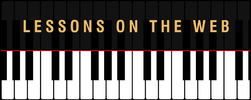|
Learning the Piano is a bit like getting dressed when the weather gets cooler. We layer...have you ever noticed that? There are actually fashion lines based on the whole layering concept. You get your first basic piece of clothing on and then add to that according to what the weather is going to be so you can remove layers as needed throughout the day, and then add back on as the evening comes. But notice...that the first layer is what always stays on; it's the first to go on and the last to come off. It's the basis of all the rest and is the closest to your skin. It's the foundation piece in a sense and the one you connect with the most through the sensing of your skin. So guess what you're first main layering piece of clothing is in your piano learning? Scales! Scales are the most important part of music to put on from your entire wardrobe of music, because every piece, every exercise and anything else that you play on the piano is built upon scales. When you first start out learning the piano, you learn how to read notes and where they are on the piano keyboard. Then you learn key signatures and time signatures to help the notes makes sense when you play them. But...the main reason we are learning the notes and rhythm is so that we can put them all together in what we call scales. Every single Key signature in music has it's own scale that we need to learn. Why is it so important to practice and learn our scales? Here are 10 benefits of knowing our scales:
Everything in piano music is basically layered on scales. Chords, moving lyrical lines, funky rhythms, they all need a scale to start with. Once you know your scales you can pick any type of layer to start putting on top, and you can change it from day to day. In fact, one of the best ways to learn a new piano piece is to make sure that you practice and know the scale that is in the same key as your piece, before you start learning the piece. Are you learning to improv? Pick a key and practice the scale in that key first. Then just start moving notes around in that scale and you're on your way. You can then add in some jazz rhythms, different time signatures or anything you'd like. That's the fun of improvisation! If you'd like some help in how to practice scales and to learn more about their benefits, take a look at this video that covers much more about scales and I show you a specific exercise that will make learning all of your scales much easier and faster than before! Stay Tuned to PianoLessonsOnTheWeb.com to learn much more and achieve your dream of playing the piano!
Leave a Reply. |
AuthorMost blogs written by Archives
June 2020
Categories
All
|


 RSS Feed
RSS Feed